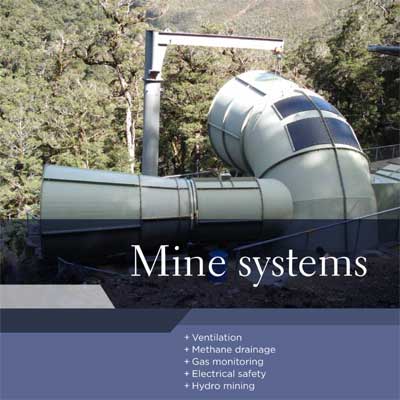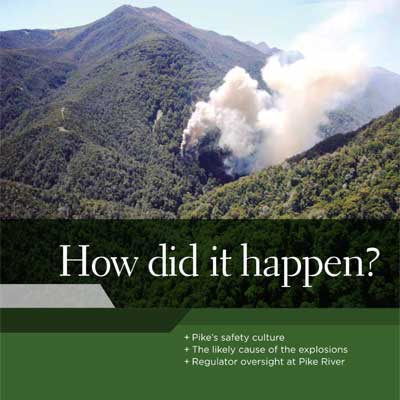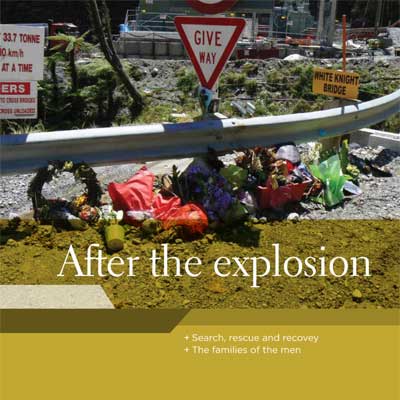Commission's Report - Volume 2
< Return to Final Report I Volume 2 - Part 2 >
PART 1: What happened at Pike River
Note: This part of the report has been divided into sections for your convenience. *These documents are in PDF format. If you are unable to open the files you can download and install Acrobat Reader for free from the Adobe website
-
List of figures (832k)*
-
Glossary (837k)* - includes Explanatory note on the page numbering of references
Download a PDF of Volume 2 - Part 1: What happened at Pike River, 4.3mb*
Context
-
CHAPTER 1 - Friday afternoon, 19 November 2010 (878k)*
-
A tragedy unfolds: Friday afternoon, 19 November 2010
-
A planned maintenance shutdown
-
Signs that all was not well
-
An electrician enters the mine
-
Calls to emergency services
-
Daniel Rockhouse
-
A rescue
-
Two miners walk out of the portal
-
The emergency response
-
-
CHAPTER 2 - Accident analysis – some concepts (862k)*
-
Introduction
-
The ‘what/why’ distinction
-
Human factors
-
Personal safety and process safety
-
The ‘Swiss cheese’ model of causation
-
-
CHAPTER 3 - The promise of Pike (1.1mb)*
-
Introduction
-
Physical characteristics of the coal field
-
Exploration of the coal field
-
From feasibility to final investment decision
-
Mine development
-
Challenges faced in 2010
-
Organisational factors
-
CHAPTER 4 - Organisational structure (835k)*
-
Board
-
Chief executive
-
Site general manager
-
Underground mine operations
-
Coal preparation plant
-
Engineering
-
Technical services
-
Project and planning
-
Safety and training
-
Environment
-
Human resources
-
-
CHAPTER 5 - Governance and management (856k)*
-
Introduction
-
Composition of the board
-
Executive management
-
Legal obligations of directors
-
Governance by the board
-
Pike’s governance documents
-
Risk assessment
-
The challenges facing the board and executive management
-
Board meetings
-
Meetings of the board’s health, safety and environment committee
-
Serious incidents at the mine
-
Challenges facing executive management in 2010
-
Conclusions
-
The future
-
-
CHAPTER 6 - The workforce (905k)*
-
Introduction
-
Workforce problems
-
Training at Pike
-
Training of workers
-
Some training issues
-
Contractor problems
-
Conclusions
-
-
CHAPTER 7 - Health and safety management (913k)*
-
Introduction
-
Health and safety management systems
-
Requirements of the Health and Safety in Employment Act 1992 (HSE Act)
-
The elements of a health and safety management system
-
The Pike approach
-
Implementing the system
-
Evaluation and monitoring
-
Management review
-
Hazard recording
-
Conclusions
-
Mine systems
-
CHAPTER 8 - Ventilation (1.5mb)*
-
Introduction
-
Who designed the Pike River ventilation system?
-
Location of the main fan
-
The ventilation management plan
-
The Pike ventilation system as built
-
The surface fan
-
The main underground fan
-
Explosion protection of the fans
-
Responsibility for ventilation at Pike
-
Sufficiency of ventilation at Pike River
-
Recorded methane spikes
-
Ventilation monitoring
-
Three key decisions
-
Conclusions
-
-
CHAPTER 9 - Methane drainage (1.2mb)*
-
Introduction
-
Overview of best practice approach to methane drainage
-
The need for pre-drainage at Pike River
-
In-seam drilling at Pike River
-
Problems with Pike River’s gas drainage system
-
Expert advice on gas drainage
-
Pike’s approach to methane management
-
Conclusions
-
-
CHAPTER 10 - Gas monitoring (1.2mb)*
-
Introduction
-
Remote gas monitoring
-
Machine-mounted and hand-held gas monitoring
-
Conclusions
-
-
CHAPTER 11 - Electrical safety (1.7mb)*
-
Introduction
-
Electrical systems at Pike River
-
The restricted and non-restricted zones
-
Proximity of non-restricted zone and electrical equipment to utility services
-
The variable speed drives
-
Regular electrical inspections
-
Electrical staffing at Pike River
-
Overall management of electrical safety at Pike River
-
Electrical inspections
-
Conclusions
-
-
CHAPTER 12 - Hydro mining (1.2mb)*
-
Introduction
-
The hydro-mining technique
-
The development of hydro mining at Pike River
-
Haste to begin hydro extraction
-
Strata control in the hydro panel
-
Ongoing problems
-
Conclusions
-
How did it happen?
-
CHAPTER 13 - Pike’s safety culture (837k)*
-
Workplace culture
-
A number of cultural influences
-
The risk of an explosion
-
Conclusions
-
-
CHAPTER 14 - The likely cause of the explosions (994k)*
-
Introduction
-
The cause of the first explosion
-
The ABM20
-
The fuel consumed in the first explosion
-
Possible sources of the methane
-
Difficulties concerning the possible sources of the methane
-
The source of ignition
-
The site of the ignition
-
Conclusions concerning the first explosion
-
The subsequent explosions
-
-
CHAPTER 15 - Regulator oversight at Pike River (875k)*
-
Introduction
-
The statutory background
-
The mining inspectorate personnel
-
The operational methods of the mines inspectors
-
Three representative interactions
-
Use of the inspectorate’s powers at Pike River
-
The inspection of mine records
-
Conclusions
-
After the explosion
-
CHAPTER 16 - Search, rescue and recovery (1mb)*
-
Deployment of Pike’s emergency response management plan (ERMP)
-
Police control of the emergency
-
So much for the principles. How were they applied in practice?
-
Role of the Department of Labour (DOL)
-
The risk assessment process
-
Assessment of survivability
-
Sealing the mine
-
The availability of information on 19 November 2010
-
Was there a ‘window of opportunity’?
-
Self-rescue
-
The deaths of the men
-
The recovery operation
-
-
CHAPTER 17 - The families of the men (855k)*
-
Introduction
-
Initial contact with family members
-
Communications with family during the rescue phase
-
Communications during the recovery phase
-
Responsibility for recovery
-
Welfare support provided to the families
-
Conclusions
-




